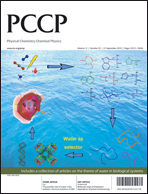Theoretical multilevel approach for studying the photophysical properties of organic dyes in solution
Abstract
Classical all-atom molecular dynamics (MD) simulations and quantum mechanical time-dependent density functional theory (TD-DFT) calculations are employed to study the conformational and photophysical properties of tetramethylrhodamine iso-thiocyanate (TRITC) in solution. The potential energy surface (


 Please wait while we load your content...
Please wait while we load your content...